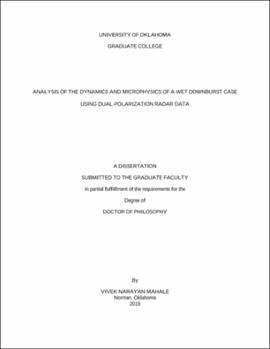| dc.description.abstract | A significant, wet downburst affected Norman, Oklahoma, on 14 June 2011. Surface winds in excess of 35 m/s (>80 mph) and hailstones in excess of 4 cm diameter occurred during the downburst. The polarimetric S-band (~11.09-cm wavelength) KOUN Weather Surveillance Radar-1988 Doppler (WSR-88D) and the rapid-scan X-band (~3-cm wavelength) polarimetric, Doppler radar (RaXPol) collected nearly simultaneous polarimetric radar data (PRD) of the downburst. The focus of this dissertation is the characterization and analysis of the dynamics and microphysics of the 14 June 2011 downburst and parent thunderstorm using various analysis methods. Analysis of the PRD from both KOUN and RaXPol radars are conducted using low-level plan position indicator (PPI) elevation scans and reconstructed range–height indicator (RHI) data. A hydrometeor classification algorithm (HCA) is applied to the KOUN PRD to understand the microphysical evolution of hydrometeors in the downburst. Dual-Doppler analysis is conducted with KOUN and the KTLX WSR-88D. Dual-frequency analysis and a comparison of the PRD are conducted between KOUN and RaXPol. Finally, a variational retrieval algorithm of rain microphysics is developed and applied to KOUN based on S-band parametrized polarimetric observation operators. Through the above analyses, an understanding of the structure and evolution of the downburst and its potential driving mechanism(s) is developed. It is found that graupel aloft transitioned to nearly all rain and hail mixture above the 0 °C level. Eventually, this large area of rain and hail mixture (i.e., mixed-phase precipitation) descended to the ground with some melting of the hail, causing the downburst. The downburst grew from a microburst at ~2.1 km horizontal scale to a macroburst at ~6.4 km in less than 7 min. As the downburst expanded, its near-surface horizontal winds intensified from 23 m/s to 42 m/s. Descending surges of mixed-phase precipitation cores aloft, indicated by a reduction in co-polar correlation coefficient (ρhv), provided a continued stream of precipitation loading and melting hail that may have aided in the continued expansion and intensity of the downburst. The unique, rapid-scan observations also captured the development of features such as a horizontal rotor, vertical vortices, multiple gust front heads, and an elevated nose on the leading edge of the gust front. The structure of the downburst is compared to the current conceptual model of a downburst and to 1-min Oklahoma Mesonet observations that were nearly collocated with the radar as well. | en_US |
